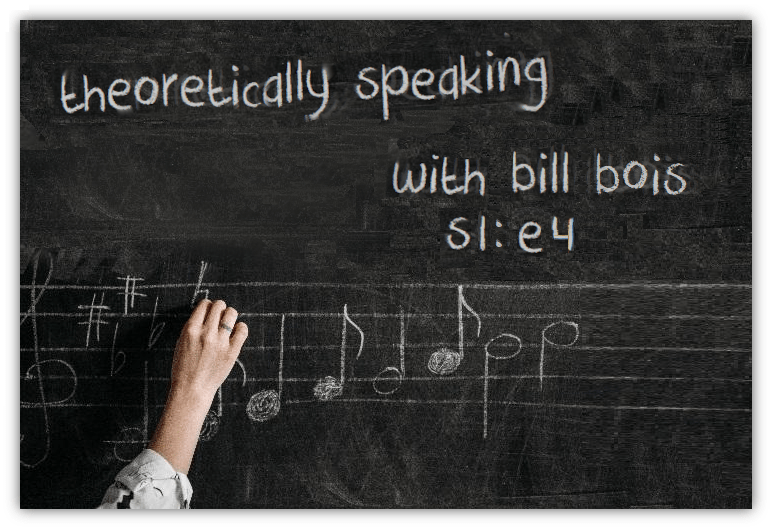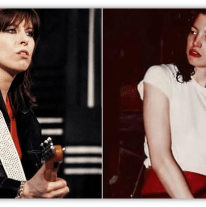Music Theory For Non-Musicians
This occasional series is about how music is made, and it’s for people who don’t already make music. It’s part music appreciation and part music theory.
I hope to cover rhythm, melody, intervals, chords, inversions, and more. Maybe we’ll get into extended chords and modes. Let’s see!
S1 : E4: Brand New Key
My mother-in-law had a habit of forgetting her own children’s names. She’d get frustrated and end up calling them Sonny, which is interesting because she only had daughters. Sometimes generic names, like Darling, Junior, or Grandma, are good for referring to the relationship rather than the actual person.
Likewise, we can refer to notes by their names, like C, D, E, F, etc. but sometimes it’s more useful to refer to them by their position in the scale. In C Major, the C is the tonic, the D is the 2nd, the E is the 3rd, F is the 4th, and so on. As we go along, sometimes I’ll use the names and sometimes I’ll use the numbers, depending on the context.
If you read the last installment, you know how to figure out the notes of the major scale. Let’s see what we can do with them.
Quick refresher, if you’re looking a piano keyboard you start at your first note, which is called the tonic, and go up two keys for the second note.
• Two more keys for the third
• only one key for the fourth
• two for the fifth
• two for the sixth
• two for the seventh
….and one to get to the octave of the tonic.
Or in musical parlance: whole step, whole step, half step, whole step, whole step, whole step, half step.
The Europeans among us might say tone, tone, semitone, tone, tone, tone, semitone.

Let’s stick with the C Major scale because it’s the easiest to visualize on a keyboard. It’s all the white keys. C, D, E, F, G, A, B, C. There are no sharps or flats.
It’s interesting that the pattern of tonic, whole step, whole step, half step, whole step, whole step, whole step, half step divides the scale into two equal parts of four notes, and both halves are whole step, whole step, half step. I show the two halves in yellow and blue here:

There’s no real reason for you to know this except to understand that the consistency is part of what makes it sound right. We’ll see the same sort of symmetry in the harmonic minor and other scales. I guess we like repeating patterns, even when they’re subliminal.
Let’s play some music.
If you have a keyboard handy, play these notes: C C G G A A G.
Take a quick rest and then play these: F F E E D D C.
Recognize it? You’ve just played the melody to Twinkle, Twinkle, Little Star, more or less. Melodies are nothing more than a series of notes that are (usually) in the song’s key. If you know the key is C Major, the song’s melody will most likely use the notes in C Major: C, D, E, F, G, A, and B. That’s certainly the case with Twinkle, Twinkle.
Here’s the entire song:
C C G G A A G
F F E E D D C
G G F F E E D
G G F F E E D
C C G G A A G
F F E E D D C
Even though this is a children’s song, there are a couple things we can learn from it. Firstly, it’s very definitely a major key. There are no sharps or flats which means that, since we’re sticking to the key of C, you don’t use any black keys.
Did you notice that the only note in the note that isn’t used is the B? In the key of C Major, B is the 7th note. There may be a reason why it wasn’t used, so keep this in mind when we talk about the 7th below.
The whole song has only two parts. The first part, meaning the first two lines, is played once at the beginning and once at the end. The second part is played twice in a row, as the third and fourth lines.
Not to repeat myself but we seem to like repetition. The reinforcement of repetition makes melodies more memorable, and everyone likes a catchy tune. You’ll hear repeating melodies in most pop songs. We’ll come back to the idea of repetition in a future article.
Also notice that the song is in C Major and it ends on a C. Melodies frequently end on the tonic of their key. That makes our ears feel like we’ve reached the conclusion, like we’re back home and everything is alright. We call this resolution.
If I were to play Twinkle, Twinkle in C Major and didn’t play the last note, everyone in the room would be on edge waiting for the C. A song doesn’t feel like it’s over until it resolves. It’s like taking a trip and never getting to your destination. It makes you feel tense.
Music is a series of transitions from tension to resolution. After all, a song or a trip that never left home would be pretty boring.
The simplest melodies move from one note to another nearby. The first section of Twinkle, Twinkle starts with a jump from the tonic to the 5th note of the scale, but every note in the rest of the phrase is from one note to the next one up or down the scale. And the second part of the melody is just four neighboring notes, descending from the G to the D. That’s from the 5th to the 2nd. It’s like walking down stairs. There are no big jumps.
The distance from one note to another is called an interval. The interval between the first two notes of Twinkle, Twinkle is from the tonic to the 5th, so we’d say it’s an interval of a 5th.
Jumping half way up the scale may seem like a lot, but there’s nothing wrong with big intervals. Sing Somewhere Over The Rainbow in your head. Or out loud if you’re in the office and want to amuse your co-workers.

The interval from “Some-” to “-where” is a full octave, from the tonic up all eight notes of the scale. Melodies rarely have intervals much bigger than that, but it can and does happen.
So, melodies can have big intervals up or down, and that can make them beautiful, or maybe ugly, and maybe hard to sing, but there are no rules limiting jumps from one note to the next. It’s really just a question of taste.
Having said that, there doesn’t have to be any intervals at all. Listen to the verse of Mr. Brightside by The Killers. It’s essentially one note.
And the verses of The Beatles’ I Am The Walrus are mostly just two notes.
We’ll get to why these one and two note melodies aren’t boring in a future article.
A few paragraphs back I said that melodies are series of notes that are usually in the same key. What do I mean by “usually?” Why would you use a note that isn’t in the key?
The answer is the same answer we always use in music theory. Because it sounds good, or at least the way that we want it to sound. Play the note that suits your purpose and we’ll figure out the theory for why it’s the right note later.
The first line of The Long And Winding Road by The Beatles is “The long and winding road that leads to your door.” It’s really a perfect melody, yet one of its notes isn’t in the key.
The song is in Eb Major so its notes are Eb, F, G, Ab, Bb, C, D, and Eb. I want to concentrate on the D, the 7th note of the scale. The words “The” and “and” are sung on the D. However, “your” is sung on a Db. Why? Db isn’t even in the Eb Major scale.
I’ve just tried playing the melody using the D natural that’s in the key and it sounds wrong. Part of that could be that I’m so used to hearing it with the Db, but also, the D natural is the 7th of the scale, only a half step from the tonic. It’s so close and yet so wrong. It grates. So flattening the 7th in this case sounds better than playing the “right” note.
This, I think, is why the 7th is more likely to be changed than any other note in the major scale. It’s too close to the tonic for comfort. Sometimes the right note is the wrong note.
Here’s my new motto for “Theoretically Speaking.” It was part of a comment on Reddit by a user named Comprimens and I ask their permission to use it here.
…if there was ever an art where breaking the rules is one of the rules, it’s music.
redditor r/Comprimens
As listeners, we should be aware that every note is a choice. The composer or the musician decided the notes we’re hearing are the right ones, whether they obey the rules or break them. Every single note’s characteristics, like pitch, volume, timbre, length, etc. are (usually) intentional. Sometimes a happy accident happens in the studio, and the artist decides to keep it. But even that’s a choice.
We, as critical listeners, get to decide if those choices were good ones.
Let the author know that you liked their article with a “heart” upvote!





I have wondered about that notion of over-learning formal musical rules, to the detriment of one’s intuitive creativity. I recently found out (from Steregum’s Callin Me Maybe, I believe) that Radiohead’s Jonny Greenwood, who is classically-trained, insisted that Thom Yorke never learn how to read music, because he wanted to retain a balance of formal vs intuitive possibilities in their songwriting together.
Perhaps he’s just being superstitious? In terms of learning, both notions seem plausible enough. Once you are comfortable enough operating within a set of rules, you feel less encumbered by them. At the same time, repetition and routine over time can create habits that are hard to shake. Maybe there’s some variation depending on who is doing it (like, temperament), how they were educated, and just how much they’d like to deviate from what they’ve learned.
But I digress! It’s good to keep that dynamic in mind, at the very least, as I’m learning. For instance, I wouldn’t want over-learning of “Twinkle Twinkle” to interfere with my playing of “Baa-Baa Black Sheep” or “The Alphabet Song.”
…..Wait a minute….
It’s something I used to be concerned about, too. I didn’t want the rules to stifle my creativity. That’s why I added the new motto to this column. Breaking the rules is one of the rules, so you might as well learn them all. In the end, it does make things easier, especially when playing with other people.
Well said. All of it.
While it doesn’t apply to music, I think the Impressionists took to heart that motto as well.
At least, that’s what I taught when I covered the history of art in my classes.
Rich Little and Fred Travalena have entered the chat.
That might explain why my favorite painter is Monet.
Is that why people say that I’m “a total Monet?”
Side note to MT: I noticed yesterday and today when I go to click the heart icon to like a post that the heart is already clicked for me, even for brand new articles!
Much appreciation for the feedback, PoA. That code is indeed a little wonky, and I’m working on improvements, or possibly junking it and starting anew.
More on this later in “The Weekend Files.”
Today’s trivia: John Lennon based the two-note “Walrus” melody on a police siren.
Another nice installment, V-dog.
Great read, V-dog. Thanks again.
Precisely! And yes, I should’ve specified that. “Twinkle, Twinkle” is an intentionally pretty melody, going to the 7th might be a little too edgy.
V-Dog,
I hope I’m not jumping the gun on future episodes, but I’ve had a burning question on my mind all weekend:
**If the first note in a song is C, does that mean the ENTIRE song is in that scale? Can the chorus/bridge be in another scale? If so, what does that look (sound) like?
(more questions to possibly follow)
Minor clarification: The first note doesn’t determine the song’s key. The key is determined by all the notes. So if you look at all the notes in a song and the vast majority of them are on the white keys, chances are the song’s in C, but it could start on any note in the key.
Anyway, songs generally don’t change keys frequently, but they can and do. Most of the time, key changes are just to give the outro a lift. The classic example is Michael Jackson’s “Man In The Mirror.” There’s a pause as he sings, “Make that change.” And just as he sings the word “change,” the song goes to a slightly higher key. Having a key change on the word “change” is a sort of audio pun.
But verses and choruses can absolutely be in different keys. The only example that comes to mind at the moment is “Beyond The Sea” by Bobby Darin. It doesn’t really have a chorus but it changes keys three times each time through the chord pattern.
I couldn’t get around to commenting on this until today, but this is terrific VDog. Each chapter you’ve brought to us noobs so far has been total light bulb moments for me – ‘that totally makes sense now!!’ Thank you for explaining it so well!
Nom-nom-nom…. 🙂